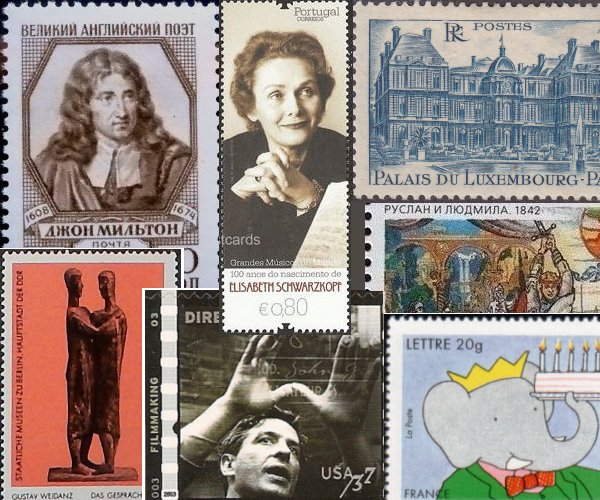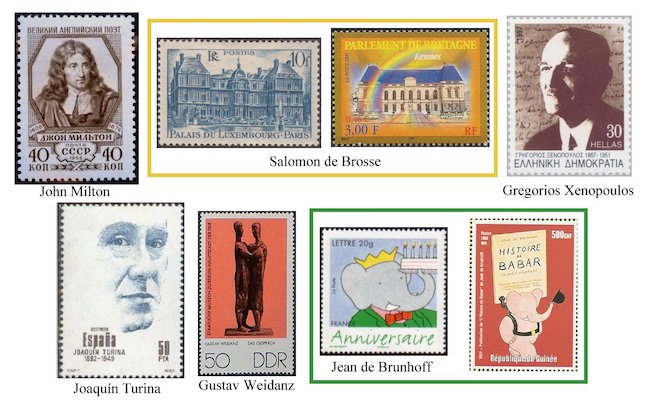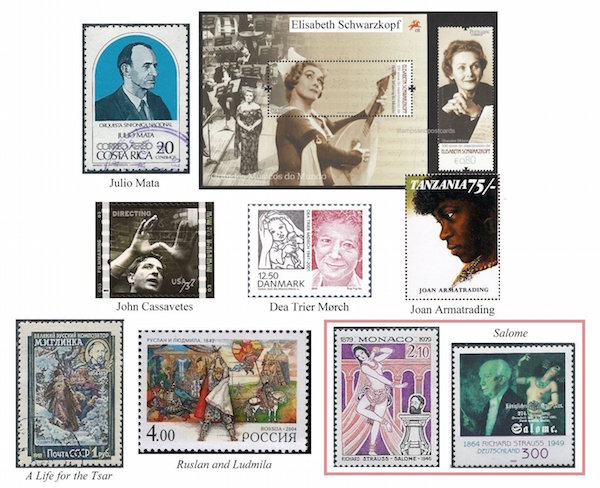The Arts on Stamps of the World — December 9
An Arts Fuse regular feature: the arts on stamps of the world.

By Doug Briscoe
John Milton tops our list today, but it would be nice if there were a stamp for his contemporary, countryman, and fellow poet Richard Lovelace, who was born 400 years ago today (9 December 1617) and died in 1657.
The incomparable poetry of John Milton (9 December 1608 – 8 November 1674) has been set to music by such composers as Thomas Arne, Britten (in the Spring Symphony), Vaughan Williams (in Hodie), Ives (the song “Evening”), Finzi, and Granville Bantock. It’s amazing to me that the only Milton stamp I can find is a Soviet one from 1958!

French architect Salomon de Brosse, born in 1571, died on this day in 1626. The son of an architect and grandson of a designer, de Brosse began his own practice in Paris in 1598 and by 1608 had been named court architect. Though a stamp has yet to be dedicated to him, two show his work, the Luxembourg Palace in Paris, built for Marie de’ Medici, and the Parlement de Bretagne in Rennes. The Rennes building, today the Court of Appeals, suffered a disastrous fire in 1994 and didn’t reopen for five years. The stamp marks the occasion. These and other designs of de Brosse proved to be a significant influence on François Mansart, a principal architect of the next generation.
The Greek journalist, novelist, and dramatist Gregorios Xenopoulos (December 9, 1867 – 14 January 1951) was for fifty years, beginning in 1896, at the helm of the magazine The Education of Children, for which he was also the primary writer. He also founded in 1927 the literary magazine Nea Estia, which is still in print. Xenopoulos was born 150 years ago today in Constantinople and grew up on his father’s island of Zakynthos. He lived in Athens from 1892, by which time he had already established himself as a writer of fiction. He wrote the first of his 46 plays in 1895. Ultimately there would be some eighty novels and many short stories. As a critic he helped introduce Constantine P. Cavafy to the reading public.
Born in Seville, Joaquín Turina (1882 – 14 January 1949) studied there as well as in Madrid and Paris, where his teachers were Vincent d’Indy and Moritz Moszkowski and where he got to know Ravel and Debussy. Returning to Madrid in 1914, he took up his career as composer, teacher (professor of composition at the Madrid Royal Conservatory from 1931), and critic. One of his students was guitarist (and dynasty founder) Celedonio Romero. Among Turina’s own compositions are two well known guitar pieces, Fandanguillo and Hommage a Tárrega, both written for Segovia. I like Wikipedia’s assessment that Turina’s music “often conveys a feeling of rapture or exaltation.” (If the stamp looks familiar, it’s because it comes from a set containing the Soler stamp I posted a few days ago—a group designed by the same artist.)
Also born on this day was German sculptor and metalworker Gustav Weidanz (1889 – 25 August 1970). He devoted much of his life to teaching. Besides fashioning a number of medallions, Weidanz created marionettes for theatrical productions in the 1920s. After World War II he lived in East Germany, and it is on a DDR stamp that he is remembered with his sculpture Das Gesprach (The Conversation). I can’t find a date for it.
Exactly ten years younger than Weidanz was Jean de Brunhoff (9 December 1899 – 16 October 1937), the co-creator of Babar the Elephant. He saw action in the very last days of World War I and committed himself to becoming a professional artist. His wife, the professional concert pianist Cécile Sabouraud, told the first Babar story to their little sons in 1930. The children were so enthusiastic about the character and story of Babar that they prevailed upon Papa to illustrate a book. This was published as The Story of Babar in 1931. It was to have borne the names of both husband and wife as the authors, but Cécile had her name removed. Six more books followed before Jean de Brunhoff’s early death to tuberculosis at age 37. The eldest son, Laurent (a third had been born in 1935), was pressed into service at age 13 coloring some of his father’s black and white drawings for two more books, and as an adult he continued the series after World War II. In addition to the expected French stamp, I found one from the Republic of Guinea.
Costa Rican composer Julio Mata (1899 – 4 March 1969) was born in the city of Cartago in the central part of the country. In 1927 he went to New York to study cello, harmony, and composition at the Brooklyn Academy of Music. Back in Costa Rica in 1932, he took up teaching and joined the Ars Nova Quartet and, in 1940, the National Symphony Orchestra as first cello. Mata’s works include an opera, Rosas de Norgaria (1933), a zarzuela, Toyupan (1938), two ballets, the symphonic poem El Libertador, a Fantasía de Navidad for children, anthems, marches, and songs.
Elisabeth Schwarzkopf (9 December 1915 – 3 August 2006), born in the province of Posen in what is now Poland, is one of the most admired sopranos of her time. In 1933, her father was dismissed by the Nazis from his position as headmaster of a small school and banned from accepting any new teaching post. As a consequence, his daughter was not allowed to enter university to pursue medical studies and, to the enormous benefit of musical posterity, went instead to the Berlin Hochschule für Musik. She studied with Maria Ivogün and joined the Deutsche Oper in 1938. In order to receive a full contract there, she met the requirement to join the Nazi party, a fact which she denied after the war. She auditioned for the important British record producer Walter Legge in 1946 and married him in 1953. Schwarzkopf was strongly associated with the rôles of Donna Elvira, the Countess in The Marriage of Figaro, and, perhaps most famously, the Marschallin in Der Rosenkavalier. Otherwise, her legacy is primarily in the Lieder repertoire and operetta. Incidentally, after her death it was reported that she was a cousin of General “Stormin’ Norman” Schwarzkopf, but from what I can gather that statement was erroneous.

The gifted filmmaker John Cassavetes (December 9, 1929 – February 3, 1989), though born in New York City, spent his earliest years in Greece and had to learn English when he returned at the age of seven. He met his wife Gena Rowlands while they were studying at the American Academy of Dramatic Arts. They were married shortly thereafter and remained so until his death 35 years later. Cassavetes acted in film and on television throughout his career, directing for the first time in 1961. With the money he made from acting he embarked on a series of independent films. Cassavetes was thrice nominated for Oscars in three different categories: Best Supporting Actor for The Dirty Dozen (1967), Best Original Screenplay for Faces (1968) and Best Director for A Woman Under the Influence (1974). The stamp comes from the sheet honoring “Behind the Scenes” aspects of filmmaking.
The parents of Danish artist and writer Dea Trier Mørch (9 December 1941 – 26 May 2001) were an architect and a musical entertainer. Her first book was a self-illustrated volume of reportage of her travels in the Soviet Union. She became a Communist Party member in the next year, 1969. Her most celebrated book was Vinterbørn (1976), translated into English as Winter’s Child, the story of the births of her three children. The story was translated into two dozen languages and made into a Danish film in 1979.
British singer-songwriter Joan Armatrading was born on the island of St. Kitts on this day 67 years ago. When she was three the family moved to Birmingham, England, leaving Joan in the care of her grandmother on Antigua. She rejoined them in England at the age of 7. Self-taught on the guitar, she began writing her own songs and performing them at local clubs. Her first album, with lyricist Pam Nestor, came out in 1972. Since then she has released seventeen more and has been thrice nominated for a Grammy.
Curiously, two Glinka operas had their premières on this date (O.S. November 27): A Life for the Tsar (aka Ivan Susanin) in 1836 and Ruslan and Ludmila in 1842; both premières were given at the Bolshoi Theatre in St. Petersburg.
And this date in 1905 saw the first performance of Richard Strauss’s masterpiece Salome at the Hofoper in Dresden.
Remaining, for the time being, without stamps are Dalton Trumbo (December 9, 1905 – September 10, 1976) and actors Douglas Fairbanks Jr. (December 9, 1909 – May 7, 2000) (though his dad has one), Kirk Douglas (who turns 101 today! born 1916), Judi Dench (1934), and John Malkovich (1953).
A graduate of the University of Massachusetts with a B.A. in English, Doug Briscoe worked in Boston classical music radio, at WCRB, WGBH, and WBUR, for about 25 years, beginning in 1977. He has the curious distinction of having succeeded Robert J. Lurtsema twice, first as host of WGBH’s weekday morning classical music program in 1993, then as host of the weekend program when Robert J.’s health failed in 2000. Doug also wrote liner notes for several of the late Gunther Schuller’s GM Recordings releases as well as program notes for the Boston Classical Orchestra. For the past few years he’s been posting a Facebook “blog” of classical music on stamps of the world, which has now been expanded to encompass all the arts for The Arts Fuse.
